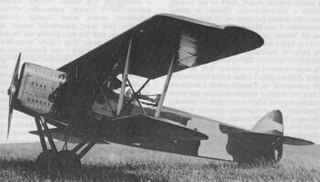
The Aero A.11 was a biplane light bomber and reconnaissance aircraft built in Czechoslovakia between the First and Second World Wars. It formed the basis for many other Czechoslovakian military aircraft of the inter-war period. Around 250 were built, with some remaining in service at the outbreak of World War II.
The Aero A.26 was a Czechoslovakian military reconnaissance biplane aircraft built by Aero Vodochody in the 1920s. It was Aero's last design to be based on the Hansa-Brandenburg B.I aircraft that the company had been building under licence during World War I as the Ae.10.

The Aero A.32 was a biplane built in Czechoslovakia in the late 1920s for army co-operation duties including reconnaissance and tactical bombing. While the design took the Aero A.11 as its starting point, the aircraft incorporated significant changes to make it suited for its new low-level role.
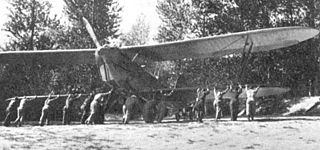
The Aero A.101 was a biplane light bomber and reconnaissance aircraft built in Czechoslovakia during the 1930s.

The Aero A.200 was a sportsplane of Czechoslovakia, designed and built specifically to compete in Challenge 1934, the European touring plane championships. It was a four-seater low-wing monoplane.

The Aero A.304 was a Czechoslovakian bomber aircraft that first flew in 1937. It had originally been developed as an airliner, the A.204, but when Aero could not find buyers for the design, it was militarised and successfully marketed to the Czechoslovak Air Force.
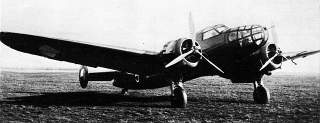
The Aero A.300 was a Czechoslovak bomber aircraft that first flew in 1938 as a much refined development of the A.304. It was designed by Aero to meet a requirement for a bomber-reconnaissance aircraft for the Czechoslovak Air Force, the Aero A-304 transport/bomber formed the basis for its design. It was a four-seat aircraft powered by two Bristol Mercury IX radial engines. The A-300 was faster than any other Czechoslovak aircraft in the inventory except for the Avia B-35 fighter. Despite showing much promise, development and production of the aircraft was stopped by the German occupation of Czechoslovakia.
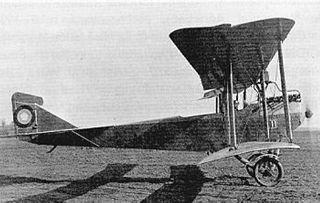
The Aero Ae 01 was a Czechoslovakian military trainer biplane built in 1919 and was Aero's first attempt to modify one of the aircraft designs they had been manufacturing under licence during World War I, the Hansa-Brandenburg B.I. The project was originally designated as Ae 10, but later re-designated to Ae 01. The army operated the aircraft under designation A-1.

The Hansa-Brandenburg B.I was an unarmed military trainer and reconnaissance biplane of World War I, flown by the Austro-Hungarian Air Service. Early models were known internally to the Hansa-Brandenburg firm as the type D, while later models with a more powerful engine were designated FD. This aircraft was one of the earliest designs of Ernst Heinkel, who was working for Hansa-Brandenburg at the time. It was an entirely conventional two-bay biplane with staggered wings of unequal span. The pilot and observer sat in tandem in a long open cockpit.
The Letov Š-16 was a Czechoslovak single-engined, two-seat biplane bomber. It was designed by Alois Šmolík at Letov Kbely. The Š-16 first flew in 1926.

The Hansa-Brandenburg C.I, also known as Type LDD, was a 2-seater armed single-engine reconnaissance biplane designed by Ernst Heinkel, who worked at that time for the parent company in Germany. The C.I had similarities with the earlier B.I, including inward-sloping interplane bracing struts. Like other early-war Austro-Hungarian reconnaissance aircraft, such as C-types of Lloyd or Lohner, the Type LDD had a communal cockpit for its crew.
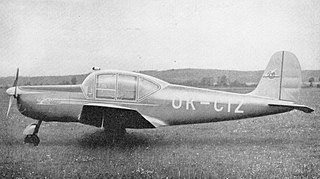
The Mráz M-3 Bonzo was a light aircraft built in Czechoslovakia in 1948 as a further development in the family of light aircraft that had commenced with the M-1 Sokol.
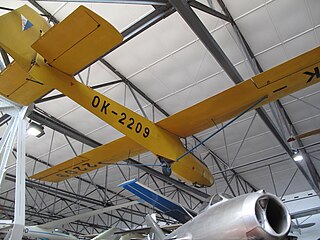
The Let LF-109 Pionýr is a glider aircraft developed by Czechoslovak manufacturer Let Kunovice. It was designed as a two-seater training aircraft and the first flight was performed in March 1950. The plane features a simple and robust design of a fabric-covered steel tube fuselage and has good flight characteristics. In total, about 470 aircraft were built.

The Phönix C.I, given serial numbers in the Phönix 121 range, was an Austro-Hungarian First World War reconnaissance and general-purpose Biplane built by Phönix and Lloyd.

The Beneš-Mráz Be-150 Beta-Junior was a light aerobatic trainer and racing aircraft, designed and built in Czechoslovakia in the late 1930s.
The Hansa-Brandenburg C.II, company designation K,, was a two-seat reconnaissance aircraft built in Germany by Hansa-Brandenburg in World War I, powered by Mercedes D.III or Hiero 6 water-cooled in-line piston engines.

The LWF model V is an American two-seat reconnaissance and training biplane built during World War One, and used for a short period afterwards. A variant specially built to test the Liberty L-12 aircraft engine, the model F, was the first aircraft to fly powered by that widely used engine.

The Praga E-51 is a Czechoslovakian reconnaissance aircraft and light bomber built by Praga in the 1930s. Development was halted by the annexation of Czechoslovakia by Germany, after only one prototype had been built. The appearance of the construction is very reminiscent of the contemporary twin engined fighter, the Fokker G.I from Holland.
The Hodek Hk-101 was a Czechoslovakian twin-engined, two seat light aircraft. Two prototypes were built in 1947, but development was abandoned after the 1948 Czechoslovak coup d'état.

The Lazarov Laz-7 was a Bulgarian training aircraft of the 1940s and 50s. The first of three prototypes flew on 12 June 1948, and was followed by 160 production aircraft powered by a Czechoslovakian Walter Minor 6-III inline engine built from 1949 to 1952, and 150 Laz-7Ms powered by a Soviet Shvetsov M-11FR radial engine from 1952 to 1954. A single example of a four-seat light transport derivative, the Laz-8, was built in 1949. The Laz-7 and Laz-7M were used by the Bulgarian Air Force as a trainer and light bomber, and surplus examples were later transferred to flying clubs, were they remained in use until the late 1960s.
















